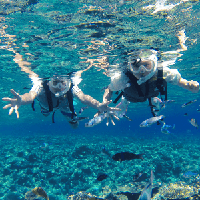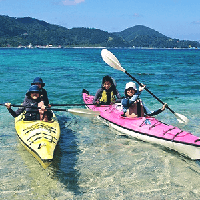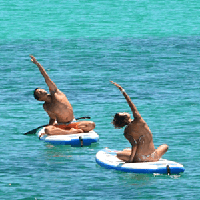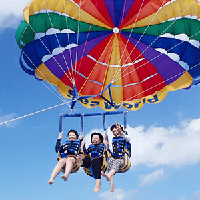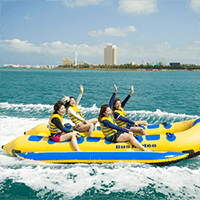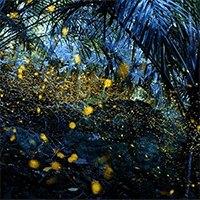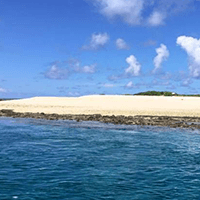List of Ie Island
- Age 3~Age 70
- 2~3 hours
- 09:00 / 11:30 / 14:00 / 16:30
Held from spring to autumn Fishing for Japanese eels in the brackish waters of rivers Part 1: 8:00-10:30 Part 2: 10:30-13:00 Part 3: 13:30-16:00 Part 4: 16:00-18:30 This is a tour to fish for eels at the mouths of rivers that run through Tokyo. Japanese eels are born in the western waters of the Mariana Islands. They grow in rivers not only in Japan but also in East Asia, including China, Taiwan, and the Korean Peninsula, and are known to return to the Mariana Islands to spawn. Japanese eels (Anguilla japonica), which belong to the Anguilla genus of the eel family, are widely distributed in East Asia, including Japan, China, Taiwan, and Korea. In Japan, they mainly live south of Honshu, but there have been cases of them being caught in Hokkaido. Rental tackle, fishing rod, and equipment are included, so you can participate empty-handed. Two patterns of fishing will be done: casting fishing and plastic bottle tackle fishing, using earthworms as bait. While waiting for the tackle, you can fish for goby at your feet. The main target is eels, but sometimes you can also catch goby, crabs, and seigo. The tour lasts about 3 hours. Please bring a headlamp, a handy light, and drinks. *If you want to take the fish home, please bring an aeration device (battery-powered bubbler) to prevent oxygen deficiency, a plastic case or fishing bucket to prevent escape, and a cooler box. By train: 15 minutes walk from JR Joban Line or Tokyo Metro Chiyoda Line By car: Please use a nearby parking lot Meeting place: Near the Seven-Eleven Katsushika Kosuge 1-chome store. We will send you a map in advance, so please walk to the point. Migration of Japanese eels Japanese eels spawn in the summer in the waters west of the Mariana Islands in the Pacific Ocean. After hatching, they become willow-leaf-shaped larvae called leptocephalus. Glass eels are carried by ocean currents and reach East Asia in about six months, then transform into long, cylindrical glass eels and ride the high tide into rivers. After that, their transparent bodies start to take on color, and they are called yellow eels. During the yellow eel stage, eels grow large, and eat a variety of foods, including shrimp, crabs, small fish, and insects. The environment in which Japanese eels spend their growth period is wide, from coastal areas to the upper reaches of rivers, and includes not only freshwater areas but also brackish water and seawater. After several years to a dozen years, when they grow to a size of about 40 cm or more for males and about 50 cm or more for females, they begin to mature and are called silver eels. Silver eels leave their familiar rivers and coastal areas and travel to spawning grounds from autumn to winter. They reach the spawning grounds in the Marianas in about six months, spawn, and then end their life. PS: The minimum number of participants is 5 or more.
- Age 3~Age 99
- Within 1 hour
- 11:00 / 13:00 / 15:00
Would you like to privately cruise around the power spot Enoshima? ? We have prepared a 30-minute short cruising that anyone can use because we want as many people as possible to experience the fun of the sea. You can enjoy the superb view of Mt.Fuji and Miura Peninsula. The view of sightseeing spots around Enoshima from the backside of the island and the view from the ocean is the best! One of the attractions is the pleasant guide of the captain who is familiar with Enoshima. Please use it to make memories of sightseeing in Shonan and Enoshima! Enoshima Marina proposes the best cruising for one page of your precious memories.
- Age 0~Age 100
- 2~3 hours
- 08:30 / 13:00
Ogasawara A superb view spot you should definitely visit! The contrast between the pure white sand and the blue sea is the best Let's go see the scenery like another world that you can't understand just by seeing it from the outside!
- Age 1~Age 70
- Over 6 hours on the day
- 08:00 / 08:40
[08:00] JR Tokyo Station, 1st floor, Marunouchi Central Exit, Shinmarunouchi Building, Depart from the 1st floor entrance under the Beams sign [08:40] Shinjuku Island It's "LOVE" Robert Indiana Departure [10:30] Shinkurayama Sengen Park 60 minutes [11:45] Hikawa Watch Shop 20 minutes [12:30] Oshino Hakkai 90 minutes (1 free Kusamochi) [14:30] Kawaguchiko Oishi Park 50 minutes (Visit on dates other than those listed below)*Seasonal Route04/05-04/14Kawaguchiko Cherry Blossom Festival10/26-11/20Kawaguchiko Momiji Corridor08/31-10/14Fuji Motosuko Resort Rainbow Flower Festival(Admission to the Fuji Shibazakura Festival is usually 1,100 yen, 600 yen for children aged 3-12, 1,400 yen during peak season, 800 yen for children aged 3-12. Please pay your own admission fee.)【15:40】Lawson Fujikawaguchiko Town hall 20 minutes【16:20】End today's trip and head home【18:50】Arrived at Shin-Maru Building and Shinjuku LOVE Statue in front of JR Tokyo Station, and the day's itinerary came to an enjoyable end! ▼ Lake Kawaguchi Oishi Park Every summer, lavender blooms in Oishi Park on the shores of Lake Kawaguchi. It is as beautiful as a carpet of purple velvet, and the contrast with Mt. Fuji in the distance is beautiful. In autumn, the broom grass in the garden turns red and its fluffy appearance is very cute. It is also the venue for the Lake Kawaguchi Herb Festival. (Lavender in June and July, begonias and cosmos in July and September, and kochia in October) ▼ Lake Kawaguchi Cherry Blossom Festival The Fuji Lake Kawaguchi Cherry Blossom Festival is held on the north shore of Lake Kawaguchi (next to the Lake Kawaguchi Ring Hall). It is a famous check-in spot where you can take photos of Mt. Fuji, the lake, and the cherry blossoms in full bloom. ▼ Lake Motosu Fuji Shibazakura Festival This is one of the largest shibazakura festivals in the metropolitan area. It is held regularly every year and is one of the largest in Japan in the metropolitan area. Approximately 800,000 shibazakura bloom in the vast plains at the foot of Mt. Fuji. The colors are vivid and beautiful. It's a flower festival. Every year from April to late May, 800,000 moss phlox bloom all at once on the shores of Lake Kawaguchi in Yamanashi Prefecture, like a "rainbow on the ground." The beautiful scenery of the magnificent moss phlox, the blue sky, and the snowy landscape of the top of Mt. Fuji is captivating to behold. A food festival is also held at the same time. The admission fee for the Fuji Moss Phlox Festival is 1,100 yen for adults, 600 yen for children aged 3 to 12, 1,400 yen during peak season, and 800 yen for children aged 3 to 12. Please pay the admission fee yourself. ▼Kawaguchiko Momiji Corridor The sight of the snow-capped Mt. Fuji and the fiery red maple leaves in harmony is not to be missed. We look forward to your participation and attendance at this rare event held once a year. The shores of Lake Kawaguchi Fuji are decorated with colorful red maples, and you will be enchanted by the majestic autumn scenery.
- Age 6~Age 75
- Over 6 hours on the day
It is a tour around the battle site where many memories sleep while considering the horror of war and the importance of peace. Ogasawara An investigator in the village battlefield survey report is guiding. The battlefield guide has visited many of the Japan battlefields in the north to Hakodate Battery and in the south to Okinawa Main Island.
- Age 20~Age 100
- 2~3 hours
- 09:00 / 13:00
A jungle island with a virgin forest with a subtropical climate Ogasawara So you can enjoy the majestic nature of nature. The main courses are Heart Rock (Shirahiroiwa), Akagashirakarasubatto Sanctuary, Ulsan, Red Flag Mountain, Umbrella Mountain, Hatsuri, Mt. Crescent, Asahiyama, Chuoyama etc. The weather is cool and easy to walk in the best season Nov. It is ~ May. other Activity For those who want to experience or have plans for sightseeing half-day I recommend a course.
良いガイドさんとマンツーマンで半日楽しくトレッキングができ、東平カラスバトサンクチュア利では固有種?のカタツムリも見られました。最高!他にも中央山、傘山は説明が良かった。トレッキングが危険度中の少。楽しくトレッキングができました。
最近チェックしたプラン
Please wait a moment
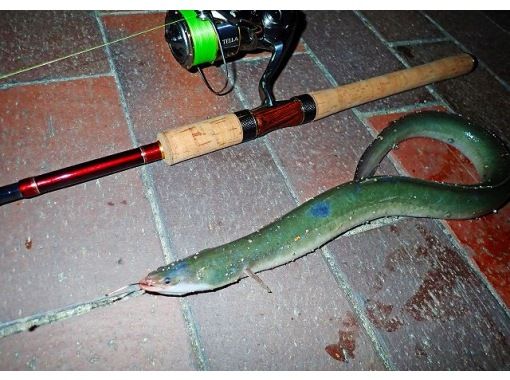
![[Complete charter] Enoshima tour cruise ♪ Feel free to enjoy a 30-minute short course! Recommended for making memories of sightseeing in Enoshima!の画像](https://img.activityjapan.com/10/46920/10000004692001_UQ6Dnzav_3.jpg?version=1690354205)
![[half-day tour of the South Island] A superb view of Ogasawara! Landing on the South Island of Galapagos, the Orientの画像](https://img.activityjapan.com/10/32885/10000003288501_533ytjtE_3.jpg?version=1593830975)
![[Shizuoka, Mt. Fuji, Bus Tour] A day trip to see the famous spots of Mt. Fuji Internet celebrities | Tenty Town | Oshino Hakkai | Lake Kawaguchi | Convenience store Lawsonの画像](https://img.activityjapan.com/10/58152/10000005815201_wXgQnW2u_3.jpg?version=1741241346)
![[Chichijima, Ogasawara Tokyo] Adventure tour (1 day course) around Ogasawara where the memories of the war ruins sleepの画像](https://img.activityjapan.com/10/6761/10000000676101_bV75BaJT_3.jpg?version=1570068505)
![[Tokyo Ogasawara] Jungle trekking on the Ogasawara island-a simple plan of half-day course with guidance by guide!の画像](https://img.activityjapan.com/10/5899/10000000589901_pbazU8ET_3.jpg?version=1569382206)
